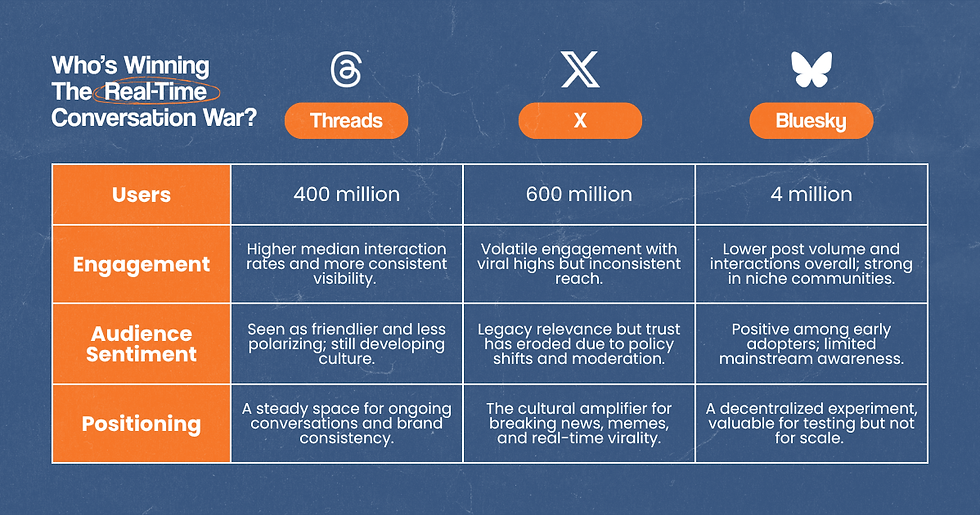How to Make the Most of Real-Time Marketing (Without Offending Your Audience)
- Eric Elkins

- Mar 16, 2023
- 4 min read
Updated: Feb 7, 2024
By: Brian Foley
Marketing has changed a lot over the recent past, though a new study shows that client concerns are forever bound to basic principles like generating traffic and creating content that resonates with their audience. Fundamentals always make for good practice, but how we achieve our clients’ goals are ever-changing in new and exciting ways. If you want to make an impact today, best practices suggest that brands use real-time data to create a personalized and interactive customer experience — known… and this is creative… as “real-time marketing.” Despite its effectiveness in the modern marketplace, others report that nearly 30% of brands haven’t engaged in any kind of real-time marketing whatsoever. This is a missed opportunity, as it is one of the best ways to achieve customer needs with smart content that drives genuine clicks based on true interest and connection.
Also, it’s very fun for marketing teams.

Real-time marketing means crafting relevant messaging on social channels by listening to and getting ahead of customer needs. It’s effective because it allows marketing professionals to react quickly to the latest news, trends, and feedback to help shape their customers’ experience (rather than content that savvy users can instantly tell feels stale, inflexible, and pre-planned). In an increasingly online world, knowing how to react towards a brand’s chosen public can feel like playing three-dimensional chess — but with preparation, research, and agility, marketing professionals can quickly jump on any pertinent opportunity to create a true marketing event for a client. You just gotta be careful, because snappy content can easily go sideways.
When Samsung’s famous-for-always-undercutting-customer-expectations competitor announced that they’d be doing away with automatically-included phone chargers, the company promptly responded with an ad featuring a charger that was “included with your Galaxy.” While some might consider this strategy akin to trolling, this kind of edge is what real-time marketing does best. By identifying stakeholders and reacting quickly, Samsung was able to capitalize on customer social media blowback with a flash campaign, demonstrate awareness of a conversation taking place at that moment by their target audience, and act quickly to offer a solution that their brand fulfills (while being entertaining, to boot). When you plant your flag over an issue you know your customers value, you’ll find that they take your side more often than not.

As most real-time marketing campaigns are unplanned, cleverness and creativity are often what sets them apart. In 2022, a massive dust storm swirled over Spain, with citizens waking up to their cars wholly caked in a layer of grit. KFC was quick to jump on this opportunity, sending out a tweet that offered free chicken to anyone in Spain who showed proof of drawing the KFC logo in the dusty windows of their car. The campaign resulted in more than 1,000 customers across Spain taking part and going to their nearest KFC restaurant to claim their reward (more than 2,000 orders in total). More importantly, the tweet campaign drove more than 9.5 million impressions and 740,350 interactions on Twitter in just the first 48 hours. By turning a low-risk event into a creative marketing opportunity, KFC created the perfect storm for a real-time marketing campaign that garnered immediate results. It may have taken 15 years, but KFC appears to have learned from comedian Patton Oswalt's iconic bit about their "failure pile in a sadness bowl": If you treat your customers like the adults they are and create a sense of fun to get them excited in the moment, you’ll reap the rewards.
However — just as the rewards for real-time marketing can be swift, failure to “read the room” can often have serious consequences. When Pepsi premiered its now-infamous ad featuring Kendall Jenner in 2017, the 21-year-old model and reality star was depicted as participating in a protest meant to mirror the Black Lives Matter movement that had captured the country’s attention. As tensions in the crowd rise, Jenner moves to the head of the pack and deters a riot by handing a police officer a can of soda. Yiiiiiiiiikes. The ad received immediate global backlash for being tone-deaf, and the company was forced to issue an apology. Most concerning to the C-suite? This fiasco had disastrous effects on Pepsi’s bottom line, leading to a loss of 4% of yearly revenue as a result.
Pepsi’s failure should serve as a lesson to companies that successful real-time marketing requires investing in balanced and measured research along with a quick wit. When a company decides to make an actual effort in anticipating stakeholder needs and concerns, they can turn to marketing professionals to steer them in the right direction — or, you know, help ensure that they don’t post anything actively offensive.

In our oversaturated online world, adopting a playful, responsive real-time marketing strategy allows brands to embed themselves into the lives, interests, and desires of their customers. While it’s not always easy to know how the future will play out, best practices suggest that companies should trust in the professionals — like WideFoc.us, as a random example — to activate customer passions and energy with strategy and attention. Want to chat about how RTM could benefit your org? Get in touch with us today!
Copywriter Brian Foley is a former college professor turned freelance content writer who spends his days in the company of his two true loves: books and records. When he's not wrapped up between the pages of a minor poet or scouring Chicago for rare vinyl, you can find him applying his unique love of research into his writing.










